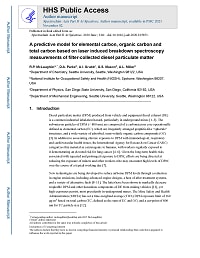Mining Publication: A Predictive Model for Elemental Carbon, Organic Carbon and Total Carbon Based on Laser Induced Breakdown Spectroscopy Measurements of Filter-collected Diesel Particulate Matter
Original creation date: June 2020
Authors: RP McLaughlin, D Parks, AI Grubb, GS Mason, A Miller
NIOSHTIC2 Number: 20059591
Spectrochim Acta, Part B: At Spectrosc 2020 Jun; 168:105871
Diesel particulate matter (DPM) produced from vehicle and equipment diesel exhaust is a common industrial inhalation hazard, particularly in underground mines. The sub-micron particles of DPM (< 800 nm) are composed of a carbonaceous core operationally defined as elemental carbon (EC), which are irregularly arranged graphitic-like “spherule” structures, and a wide-variety of adsorbed, semi-volatile organic carbon compounds (OC). In addition to associating chronic exposure to DPM with immunological, respiratory and cardiovascular health issues, the International Agency for Research on Cancer (IARC) categorizes this material as carcinogenic to humans, with workers regularly exposed to it demonstrating an elevated risk for lung cancer. Given the long-term health risks associated with repeated and prolonged exposure to DPM, efforts are being directed at reducing the exposure of miners and other workers who may encounter high levels of DPM over the course of a typical working day.
In this study, a partial least squares (PLS) regression model was generated from laser-induced breakdown spectroscopy and NIOSH Standard Method 5040 data derived from DPM samples collected on quartz fiber filters to evaluate the effectiveness of LIBS measurements in predicting OC, EC, and TC in air samples. The results provided here suggest that LIBS measurements coupled with PLS modeling represents a promising direction for the rapid analysis of DPM concentrations.

NIOSHTIC2 Number: 20059591
Spectrochim Acta, Part B: At Spectrosc 2020 Jun; 168:105871
- Aerosols Emitted in Underground Mine Air by Diesel Engine Fueled with Biodiesel
- A Computer Software Program that Estimates Air Quantity Requirements in Large Opening Stone Mines
- Effects of Sampling Artifacts on Occupational Samples of Diesel Particulate Matter
- The Effects of Water Emulsified Fuel on Diesel Particulate Matter Concentrations in Underground Mines
- The Fate of Metal (Fe) During Diesel Combustion: Morphology, Chemistry, and Formation Pathways of Nanoparticles
- The Relationship between Elemental Carbon and Diesel Particulate Matter in Underground Metal/Nonmetal Mines in the United States and Coal Mines in Australia
- Relationship Between Elemental Carbon, Total Carbon, and Diesel Particulate Matter in Several Underground Metal/nonmetal Mines
- Technology News 514 - The Air Quantity Estimator (AQE): A New Computer Software Tool for Large-opening Mine Ventilation Planning
- Toward developing a new occupational exposure metric approach for characterization of diesel aerosols
- Towards a Field-Portable Real-Time Organic and Elemental Carbon Monitor